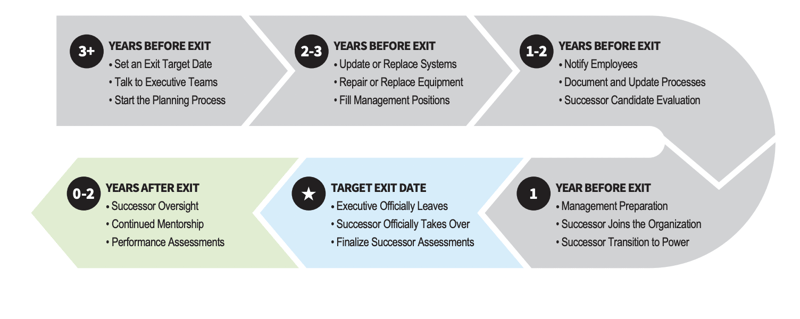Business Intelligence Empowers Strategic Decisions
Most companies struggle to pinpoint the reasons behind declining productivity, rising costs, or stagnant growth. Many deploy analytical tools in...

Statistics paint a grim picture of how many businesses (many of which are family-owned or controlled) survive the ten-year mark. However, if business owners follow the succession planning process, they can beat the statistics and set their business up for generations of success.
Aging leadership is a challenge across industry segments as the average business owner is 50 years old. Executives in the baby boom generation are now between 57 and 75 years old, and many do not have succession plans to guarantee the survival of the businesses they worked so hard to build.
Business succession planning is vital for younger executives as well. The sudden loss of leadership often throws organizations into a downward spiral with no clear direction, loss of critical employees and plummeting revenues as once-loyal customers struggle to connect to the new regime.
A high proportion of small businesses are family-owned. However, statistics show that only a small portion of companies successfully transition to the next generation. Further, companies without a succession plan struggle to maintain employee morale and engagement, negatively impacting sales and customer retention.
A successful business succession plan covers four primary phases starting with preparation. First, organizations must meticulously document procedures, update systems, or replace them with modern applications designed for tomorrow’s industry leaders and ensure a smooth knowledge transfer. Second, choosing the best successor without concise evaluation criteria and plans poses an enormous risk. Third, transitions are most successful when existing leadership can slowly transition knowledge and responsibilities to the new management team. Finally, executives can exit the business with a continued role as mentors or advisors to ensure continued success for the company, customers, and employees.
TOMORROW’S DIGITAL AND MOBILE BUSINESS LEADERS
Tenured executives remember ledger books, printed receipts, and their first green screen computer programs. Young business leaders are accustomed to having information in the palm of their hand, anytime, anywhere, on any device. Conversely, legacy ERP systems require complex connections for mobility or remote access. Outgoing executives should consider replacing aging ERP systems with a modern, cloud ERP application like Acumatica. The holistic business application is robust, scalable, and intuitive for the next generation of business leaders.
Transitioning leadership strains every business, with each facing unique challenges. In addition, successful transition plans must meet the specific needs of the company’s industry. For example, manufacturers’ transition plans differ significantly from construction or wholesale distribution plans. Therefore, make sure to consider industry requirements related to product knowledge, business processes, and related factors.
Opinions may vary slightly, but every succession plan follows four general steps—preparation, evaluation, transition, and exit. Preparation is vital to ensure key employees and staff are ready for the change, systems are updated or replaced with modern and intuitive applications, and transition processes are clearly defined. The second step sets criteria to evaluate potential successors and establishes the evaluation process and timeline. Next, the outgoing executive transitions power to their successor. The most successful transitions allow exiting executives to work alongside their successors before leaving the organization. Finally, outgoing leadership mentors their successor with periodic oversight to safeguard business operations.
A familiar mistake executives make is rushing their exit. Instead, planning should start years before the exit date. Extended time allows the outgoing executive to clean house and make changes to empower their successor’s chances for success. It also enables the retiring executive to work alongside their successor before leaving the organization. Finally, after officially departing from the organization, the exiting executive continues to work with their successor in an advisory and oversight role. Below is a sample timeline of milestones in the succession planning process.
 How Prepared Are You?
How Prepared Are You?Business owners struggle to get their businesses in order before leaving the organization. Despite best intentions, they find themselves pulled in different directions with little time to focus on transitioning the company to their successor. This playbook includes a survey designed to help executives understand how they stack up against best practices and help them prioritize succession planning activities.
SUCCESSION TRANSITIONS IN THE PANDEMIC ERA
There are few bright spots in global pandemics. However, the recent Future of Work study by SMB Group found that just under half of business leaders accelerated technology adoption due to the pandemic. The report further illustrates how businesses improve agility with collaboration tools and automation while reacting to employee mobility and telework preferences. Modern business applications like Acumatica Cloud ERP set a foundation for tomorrow’s younger workforce.
Aging business owners often struggle to transition their business to the next generation. Unfortunately, few family-owned businesses make it to the next generation, and fewer make it to the third generation. Lack of succession plans disrupts business operations, hurts employee morale, and causes a lack of continuity that frustrates customers and limits growth.
The four-step succession plan prepares executives to manage their transition effectively. First, prepare business systems and management for the change. Next, set successor candidate criteria and identify the best possible person to take over when you leave. Finally, work with your successor during the transition period and continue to mentor them and evaluate their performance after your departure.
Modern Cloud ERP applications like Acumatica improve succession planning by providing an intuitive user interface, robust features, and a friendly mobile application for younger leaders. In fact, Acumatica is consistently highly rated for usability by industry analysts and customers alike. Further, role-based dashboards, configurable workflows, and actionable reports and inquiries empower leaders with real-time information to manage the entire business.

Most companies struggle to pinpoint the reasons behind declining productivity, rising costs, or stagnant growth. Many deploy analytical tools in...

In the competitive world of Enterprise Resource Planning (ERP) software, businesses must choose a solution that meets their needs while driving...

Selecting the right financial management system is crucial for the success and expansion of any organization. Among the many options available for...